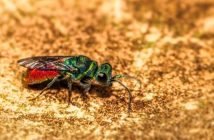The UK’s only rocket to successfully launch a satellite into orbit is to be unveiled in Scotland, the BBC recently reported. But the first stage of the Black Arrow R3 rocket really belongs on the Isle of Wight.
Black Arrow R3, a British satellite carrier rocket, will go on display after a 10,000-mile journey back home from its crash-landing site at the Anna Creek Cattle Station in the South Australian outback 48 years ago.
For years the remains of Black Arrow R3 have been on display at the William Creek Memorial Park. Extreme Australian weather and vandals have done their worst to what is left of the superstructure.
Edinburgh-based space technology firm Skyrora director Daniel Smith described Black Arrow as “quite feasibly the most important artefact linked to the UK’s space history” and will display the rocket near his company’s headquarters in Scotland.
“We really hope the rocket will help to inspire current and future generations of scientists and engineers,” Daniel says.
The sentiments of Skyrora and Daniel Smith are laudable. Seeing the Black Arrow, in all her glory, could well inspire a new generation to look to the stars and encourage them to become rocket scientists and space programme pioneers. Marking the Australian crash site with a commemorative plaque is also to be commended.
I would love to go and see the rocket next time I am in Scotland, but really Black Arrow belongs at the opposite end of the country.
Black Arrow was developed by Saunders-Roe and Westland Aircraft in East Cowes, Isle of Wight, off the south coast of England. It was tested at top secret facilities at High Down overlooking the famous Needles landmark between 1969 and 1971.
I visited the remote, windswept test site overlooking the Needles Battery and lighthouse with Company-X communications manager Chris Gardner last July. Much of the supporting superstructure is still in situ, and it’s evident that rockets were tested there. But there’s very little to commemorate the fact. It seems like a missed opportunity to celebrate one of Britain’s biggest accomplishments.
Wouldn’t it be fantastic if Black Arrow eventually returned to her test site? Even for temporary exhibition. Then, perhaps, the Islanders could be among those inspired to become the next generation of space pioneers. Black Arrow could take pride of place alongside the Isle of Wight’s other innovations.
Radio pioneer Guglielmo Marconi experimented with radio transmission to ships at sea at the Royal Needles Hotel, above Alum Bay, in 1897 and sent the first wireless transmission as Queen Victoria looked on. Seismograph inventor John Milne died at Shide, Isle of Wight, in 1913.
The island offers the UK’s only public hovercraft service between Ryde and Southsea, thanks to British mechanical engineer Sir Christopher Cockerell who was the first to develop a successful skirt and demonstrate a practical hovercraft vehicle in continued use.
Ryde engineer and inventor John Ackroyd built the first practical electric city car, the Enfield 8000, on the Island in 1970. He also designed and built the world’s fastest vehicle, Thrust 2, on the Island, and was on the team whose balloon went the highest a human had been (64,000 ft, ~12 miles).




